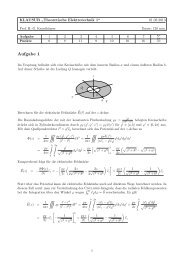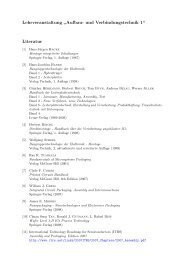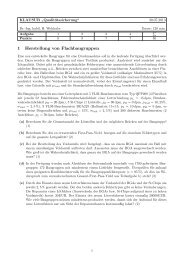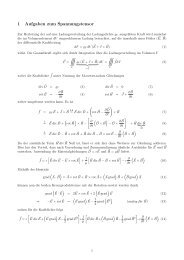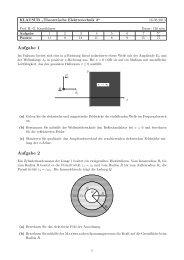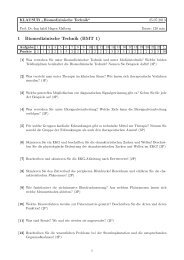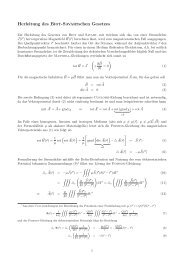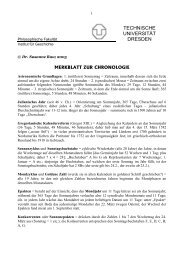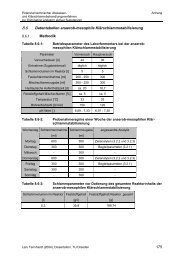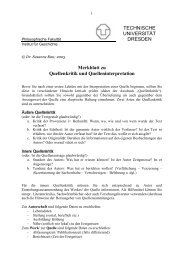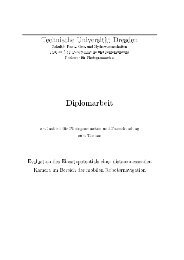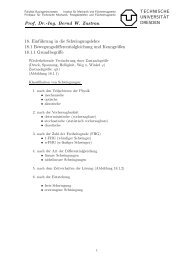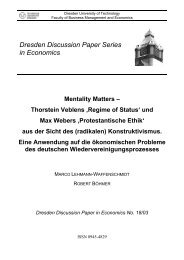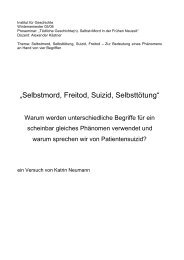Dresden Discussion Paper Series in Economics
Dresden Discussion Paper Series in Economics
Dresden Discussion Paper Series in Economics
You also want an ePaper? Increase the reach of your titles
YUMPU automatically turns print PDFs into web optimized ePapers that Google loves.
<strong>Dresden</strong> University of Technology<br />
Faculty of Bus<strong>in</strong>ess Management and <strong>Economics</strong><br />
<strong>Dresden</strong> <strong>Discussion</strong> <strong>Paper</strong> <strong>Series</strong><br />
<strong>in</strong> <strong>Economics</strong><br />
R&D expenditure <strong>in</strong> G7 countries and<br />
the implications for endogenous<br />
fluctuations and growth<br />
KLAUS WÄLDE<br />
ULRICH WOITEK<br />
<strong>Dresden</strong> <strong>Discussion</strong> <strong>Paper</strong> <strong>in</strong> <strong>Economics</strong> No. 3/03<br />
ISSN 0945-4829
Address of the author(s):<br />
Klaus Wälde<br />
Technical University <strong>Dresden</strong>,<br />
Department of <strong>Economics</strong><br />
Mommsenstr. 13<br />
01062 <strong>Dresden</strong><br />
Germany<br />
e-mail : waelde@iwb-dresden.de<br />
Ulrich Woitek<br />
University of Munich,<br />
Department of <strong>Economics</strong><br />
80539 Munich<br />
Germany<br />
e-mail : u.woitek@lrz.uni-muenchen.de<br />
Editors:<br />
Faculty of Bus<strong>in</strong>ess Management and <strong>Economics</strong>, Department of <strong>Economics</strong><br />
Internet:<br />
An electronic version of the paper may be downloaded from the homepage:<br />
http://rcswww.urz.tu-dresden.de/wpeconomics/<strong>in</strong>dex.htm<br />
English papers are also available from the SSRN website:<br />
http://www.ssrn.com<br />
Work<strong>in</strong>g paper coord<strong>in</strong>ators:<br />
Michael Berlemann<br />
Oliver Greßmann<br />
e-mail: wpeconomics@mailbox.tu-dresden.de
<strong>Dresden</strong> <strong>Discussion</strong> <strong>Paper</strong> <strong>in</strong> <strong>Economics</strong> No. 3/03<br />
R&D expenditure <strong>in</strong> G7 countries and<br />
the implications for endogenous<br />
fluctuations and growth<br />
Klaus Wälde Ulrich Woitek<br />
Technical University <strong>Dresden</strong> University of Munich<br />
Department of <strong>Economics</strong> Department of <strong>Economics</strong><br />
01062 <strong>Dresden</strong> 80539 Munich<br />
waelde@iwb-dresden.de u.woitek@lrz.uni-muenchen.de<br />
Abstract:<br />
The literature on endogenous growth cycles predicts countercyclical R&D expenditure. Aggregate R&D expenditure <strong>in</strong><br />
G7 countries from 1973 to 1997 seems to be procyclical. Implications for future theoretical research are discussed.<br />
JEL-Classification: C2, E32, O41<br />
Keywords: Cyclical Properties of R&D Expenditure; Growth Cycles<br />
We are grateful to Gunter Coenen, Antonio Fatas, Gerhard Glomm, Alfred Mausner, Bernd Süssmuth and Mark Weder<br />
for many constructive comments and discussions.
1 Introduction<br />
Growth rates of virtually all economic variables are time vary<strong>in</strong>g. The reasons<br />
for these fluctuations are manyfold. Some of the factors imply<strong>in</strong>g nonconstant<br />
growth rates can reasonably be considered to be exogenous. Oil<br />
price shocks, shifts <strong>in</strong> preferences or sometimes also shifts <strong>in</strong> expectations<br />
can be put <strong>in</strong> this category. However, fluctuations can also be the result of<br />
events that are endogenous to an economy. As Bental and Peled (1996), Matsuyama<br />
(1999, 2001) and Wälde (1999, 2002) have stressed, <strong>in</strong>tentional R&D<br />
by profit maximiz<strong>in</strong>g firms can not only be the source for positive long-run<br />
growth rates but also for short-run fluctuations.<br />
Models presented by these authors comb<strong>in</strong>e capital accumulation with<br />
R&D. Generally speak<strong>in</strong>g, these model economies feature a growth path on<br />
which periods of high growth are followed by periods of low growth and vice<br />
versa. Similarily, periods of high <strong>in</strong>novative activity are followed by periods of<br />
low <strong>in</strong>novative activity. Whereas <strong>in</strong> Matsuyama’s work, a temporary patent<br />
protection for <strong>in</strong>novators leads to a synchronization of <strong>in</strong>novative activity, it<br />
is relative returns for <strong>in</strong>vestors <strong>in</strong> Bental and Peled and Wälde’s approach<br />
that coord<strong>in</strong>ates <strong>in</strong>vestment decisions.<br />
A common prediction of these models is a countercyclical allocation of<br />
resources to R&D. 2 In periods of high returns to capital (or no patent protection)<br />
and high growth of GDP, few resources are allocated to R&D. With low<br />
returns to capital (or temporary patent protection) and low growth, resource<br />
allocation to R&D is high. Empirically speak<strong>in</strong>g, resource allocation to R&D<br />
should be negatively correlated with growth rates of GDP. The present paper<br />
teststhisprediction.<br />
A widely used technique to do this is to detrend the data us<strong>in</strong>g the<br />
Hodrick-Prescott (HP) filter and calculate descriptive statistics based on the<br />
filtered series. However, it is well known that the HP filter can create spurious<br />
cyclical structure and spurious correlations (Harvey and Jaeger, 1993) if<br />
the series is I(0). Given the limited reliability of unit-root tests (e.g. Banerjee<br />
et al. 1993) to discrim<strong>in</strong>ate between I(0) and I(1) series, and the shortness<br />
of our time series, we adopt the approach proposed by Canova (1998). We<br />
compare the outcome for filter<strong>in</strong>g techniques with different implications for<br />
the nature of the non-stationarity, and judge the robustness of our results by<br />
compar<strong>in</strong>g the outcome.<br />
Evidence on cyclical behaviour of R&D is provided by Sa<strong>in</strong>t-Paul (1993)<br />
and Geroski and Walters (1995). Sa<strong>in</strong>t-Paul uses a VAR approach and f<strong>in</strong>ds<br />
2Francois and Lloyd-Ellis (forthcom<strong>in</strong>g) obta<strong>in</strong> this result <strong>in</strong> a multi-sector economy<br />
without capital accumulation.<br />
2
”very little evidence of any pro- or countercyclical behavior” of R&D activity<br />
(measured by R&D expenditure). Geroski and Walters, us<strong>in</strong>g UK <strong>in</strong>novations<br />
and patents data, f<strong>in</strong>d some procyclical behavior of these quantities<br />
(correlation coefficients of .62 and .23, respectively). Fatas (2000) provides a<br />
plot of growth rates of R&D expenditure and GDP for the USA from 1961 to<br />
1996 and argues that they are procyclical. We complement these studies by<br />
be<strong>in</strong>g more comprehensive both with respect to countries and years covered,<br />
by us<strong>in</strong>g different data and methods and by stress<strong>in</strong>g the l<strong>in</strong>k to theories of<br />
endogenous fluctuations and growth.<br />
2 Results<br />
2.1 The data and descriptive statistics<br />
We study G7 countries and use annual data for the period from 1973 - 1997.<br />
This time period and frequency was largely dictated by the availability of data<br />
on R&D. Data on <strong>in</strong>dustrial R&D expenditure <strong>in</strong> current national prices are<br />
from OECD (1997, 2000a). GDP data <strong>in</strong> current national prices and price<br />
deflators used to express time series <strong>in</strong> 1995 prices are from OECD (2000b).<br />
R&D and GDP data were divided by total employment (OECD, 2000b) and<br />
the result<strong>in</strong>g per-capita (i.e. per number of workers) series were used for all<br />
computations.<br />
Time series for Germany cover West Germany only. As data for West<br />
Germany was not available up to 1997, data for West Germany for 1991<br />
to 1997 were constructed by multiply<strong>in</strong>g data for Germany as a whole by<br />
the 1991 - 1994 average ratio of West German to German data. As results<br />
obta<strong>in</strong>ed for Germany do not qualitatively differ from results for other G7<br />
countries, these added observation errors do not seem to be substantial.<br />
The annual (unweighted) average growth rate of real per-capita GDP<br />
of G7 countries amounts to 1.6%, rang<strong>in</strong>g from .9% for Canada and 2.3%<br />
for Japan. The annual (unweighted) average growth rate of real per-capita<br />
R&D expenditure of G7 countries lies at 3.1% with extreme values at 1.3%<br />
for the UK and 4.7% for Japan and Canada. In each country, except the<br />
UK, the growth rate of R&D expenditure lies above the growth rate of GDP.<br />
The ratio of R&D expenditure to GDP <strong>in</strong> 1997 lies between .5% <strong>in</strong> Italy and<br />
2.1% <strong>in</strong> Japan. Volatility (measured by the standard deviation of the cyclical<br />
component of a time series detrended by the HP filter with a smooth<strong>in</strong>g<br />
parameter λ =100) of R&D exceeds volatility of GDP by a factor between<br />
approx. 2.1 for the UK and 5.6 for Canada. Due to this much higher volatility<br />
(unweighted average 3.6), R&D expenditure can be considered to behave very<br />
3
similarily to ”normal” <strong>in</strong>vestment.<br />
2.2 Cross correlations<br />
The trend and cyclical components of a time series were obta<strong>in</strong>ed by apply<strong>in</strong>g<br />
the various filters on logarithms of per-capita GDP and per-capita R&D data.<br />
We use the HP filter, a modified Baxter-K<strong>in</strong>g filter (BKM), the Christiano-<br />
Fitzgerald filter (CF) and a difference filter (DF), i.e. we computed growth<br />
rates by comput<strong>in</strong>g the differences of logs of time series. The smooth<strong>in</strong>g<br />
parameter for the HP filter was λ =100and λ =6.25 (suggested recently by<br />
Ravn and Uhlig, 2002), the modified Baxter-K<strong>in</strong>g (1999) filter has a cut-off<br />
frequency of 15 years, the filter length is 3. The undesireable sidelobes <strong>in</strong> the<br />
ga<strong>in</strong> function are taken care of by the so called Lanczos’s σ-factors (as used<br />
<strong>in</strong> A’Hearn and Woitek, 2001). For the Christiano-Fitzgerald (1999) filter,<br />
the cut-off frequency is aga<strong>in</strong> 15 years.<br />
Correlation coefficients and correspond<strong>in</strong>g t− and p−values were obta<strong>in</strong>ed<br />
by regress<strong>in</strong>g centered cyclical components of per-capita R&D data on centered<br />
cyclical components of per-capita GDP, correct<strong>in</strong>g standard errors for<br />
heteroskedasticity and autocorrelation (Newey and West, 1987). Results on<br />
contemporanous correlations are presented <strong>in</strong> table 1. 3<br />
One, two and three asterisks <strong>in</strong>dicate significance at the ten, five and<br />
one percent level, respectively. The overall impression is one of a positive<br />
correlation. 25 out of 35 estimates are positive, of which 15 are significant.<br />
Negative correlation coefficients were estimated for Canada (4 out of 5), for<br />
Italy (5 out of 5) and the U.S. (1 out of 5) of which only one is significant.<br />
Correlations for lagged R&D expenditure were computed as well and are<br />
available upon request. No easily identifiable pattern emerged. We also<br />
looked at the correlation between <strong>in</strong>vestment (gross fixed capital formation<br />
from OECD, 2001) and R&D expenditure. 4 Here, only 4 out of 35 estimated<br />
correlation coefficients were negative, and none was significant. By contrast,<br />
9 positive correlation coefficients were significant. The hypothesis of a negative<br />
correlation between R&D expenditure and GDP (or <strong>in</strong>vestment) made<br />
by theory is clearly rejected.<br />
3 A visual impression of the cyclicality of R&D expenditure can be ga<strong>in</strong>ed from the plot<br />
on the last page of this paper, obta<strong>in</strong>ed by us<strong>in</strong>g the HP filter with λ = 100.<br />
4 It could be argued that the most direct prediction of exist<strong>in</strong>g models of endogenous<br />
fluctuations is the switch<strong>in</strong>g allocation of sav<strong>in</strong>gs to either capital accumulation or R&D<br />
and hence their negative correlation. The negative correlation between R&D expenditure<br />
and GDP is an immediate consequence.<br />
4
HP100 HP6.25 DF BKM CF<br />
CAN ρ -0.028 -0.164 -0.020 -0.195 0.006<br />
t-value -0.124 -0.893 -0.099 -0.888 0.021<br />
p-value 0.902 0.381 0.922 0.386 0.983<br />
FRA ρ 0.132 0.000 0.353 ∗∗∗ 0.081 0.031<br />
t-value 0.639 0.000 3.225 0.444 0.119<br />
p-value 0.529 1.000 0.004 0.662 0.906<br />
GER ρ 0.341 ∗∗ 0.312 ∗ 0.275 ∗∗ 0.330 ∗ 0.337 ∗<br />
t-value 2.330 1.797 2.132 1.807 1.953<br />
p-value 0.029 0.085 0.044 0.087 0.065<br />
ITA ρ -0.227 -0.115 -0.113 -0.145 -0.355 ∗<br />
t-value -1.322 -0.666 -0.743 -0.840 -2.076<br />
p-value 0.199 0.512 0.465 0.412 0.051<br />
JPN ρ 0.478 ∗ 0.571 ∗∗∗ 0.522 ∗∗∗ 0.640 ∗∗∗ 0.461<br />
t-value 1.783 4.869 3.375 3.535 1.547<br />
p-value 0.087 0.000 0.003 0.002 0.138<br />
GBR ρ 0.488 ∗∗∗ 0.499 ∗∗∗ 0.423 ∗∗∗ 0.368 ∗∗ 0.456 ∗∗<br />
t-value 2.956 3.932 5.119 2.317 2.115<br />
p-value 0.007 0.001 0.000 0.032 0.047<br />
USA ρ 0.170 0.116 0.141 -0.053 0.245<br />
t-value 0.873 0.675 0.568 -0.258 1.015<br />
p-value 0.392 0.506 0.576 0.799 0.322<br />
Table 1: Correlation coefficients between GDP and R&D expenditure for G7 countries<br />
3 Conclusion<br />
What do these f<strong>in</strong>d<strong>in</strong>gs imply for further research? Bental and Peled (1996)<br />
briefly and Francois and Lloyd-Ellis (forthcom<strong>in</strong>g) extensively discuss empirical<br />
evidence on countercyclical R&D expenditure. 5 These authors provide<br />
evidence <strong>in</strong> favour of their - and therefore also - Matsuyama’s and Wälde’s<br />
approach. Generally speak<strong>in</strong>g, some R&D activities (<strong>in</strong> a broad sense <strong>in</strong>clud<strong>in</strong>g<br />
reorganization of production or managment processes and tra<strong>in</strong><strong>in</strong>g)<br />
<strong>in</strong>deed seem to <strong>in</strong>crease dur<strong>in</strong>g downturns. On the other hand, it seems fair<br />
to argue that there is stronger evidence for procyclical rather than countercyclical<br />
behavior of R&D expenditure from the analysis undertaken here.<br />
While data might rema<strong>in</strong> <strong>in</strong>conclusive for some time, future research<br />
should focus on mak<strong>in</strong>g models more flexible. Other specifications might<br />
5 Cf. also Sa<strong>in</strong>t Paul (1993, 1997) on the related ”opportunity cost” literature.<br />
5
imply R&D expenditure whose cyclical behavior depends on parameter values.<br />
This might then help to f<strong>in</strong>d new empirical strategies that would allow<br />
to understand why there is both pro- and countercyclical evidence of R&D<br />
<strong>in</strong> a broad sense.<br />
References<br />
[1] A’Hearn, B. and Woitek, U., 2001, More International Evidence on the<br />
Historical Properties of Bus<strong>in</strong>ess Cycles. Journal of Monetary <strong>Economics</strong><br />
47: 321 - 346.<br />
[2] Banerjee, A., Dolado, J., Galbraith, J. and Hendry, D., 1993, Co<strong>in</strong>tegration,<br />
Error-Correction and the Econometric Analysis of Non-Stationary<br />
Data. Oxford University Press, Oxford.<br />
[3] Baxter, M. and K<strong>in</strong>g, R. G., 1999, Measur<strong>in</strong>g Bus<strong>in</strong>ess Cycles. Approximate<br />
Band-Pass Filters for Economic Time <strong>Series</strong>. Review of <strong>Economics</strong><br />
and Statistics 81: 575-593.<br />
[4] Bental, B., Peled, D., 1996, The accumulation of wealth and the cyclical<br />
generation of new technologies: A Search Theoretic Approach. International<br />
Economic Review 37, 687 - 718.<br />
[5] Canova, F., 1998, Detrend<strong>in</strong>g and Bus<strong>in</strong>ess Cycle Stylized Facts. Journal<br />
of Monetary <strong>Economics</strong> 41: 475-512.<br />
[6] Christiano, L. and Fitzgerald, T., 1999, The Band Pass Filter. NBER<br />
Work<strong>in</strong>g <strong>Paper</strong> No 7257.<br />
[7] Fatás, A., 2000, Do Bus<strong>in</strong>ess Cycles Cast Long Shadows? Short-Run<br />
Persistence and Economic Growth. Journal of Economic Growth 5: 147<br />
-162.<br />
[8] Francois, P. and Lloyd-Ellis, H., forthcom<strong>in</strong>g, Animal Spirits Through<br />
Creative Destruction. American Economic Review.<br />
[9] Geroski, P. A. and Walters, C. F., 1995, Innovative Activity over the<br />
Bus<strong>in</strong>ess Cycle. Economic Journal 105: 916 - 928.<br />
[10] Harvey, A. C. and A. Jaeger, 1993, Detrend<strong>in</strong>g, Stylized Facts and the<br />
Bus<strong>in</strong>ess Cycle. Journal of Applied Econometrics 8: 231-247.<br />
[11] Matsuyama, K., 2001, Grow<strong>in</strong>g through Cycles <strong>in</strong> an Inf<strong>in</strong>itely Lived<br />
Agent Economy. Journal of Economic Theory 100: 220 - 234.<br />
6
[12] Matsuyama, K., 1999. Grow<strong>in</strong>g through cycles. Econometrica 67, 335 -<br />
347.<br />
[13] Newey, W. K. and West, K. O., 1987, A Simple, Positive Semi-def<strong>in</strong>ite,<br />
Heteroskedasticity and Autocorrelation Consistent Covariance Matrix.<br />
Econometrica 55: 703 - 708.<br />
[14] OECD, 2001, International sectoral database. OECD [Organization for<br />
Economic Co-Operation and Development], Paris.<br />
[15] OECD , 2000a, Research and Development Expenditures <strong>in</strong> Industry<br />
1977-1998. OECD, Paris.<br />
[16] OECD, 2000b, Statistical Compendium Edition 1.2000 (on CD). OECD,<br />
Paris.<br />
[17] OECD , 1997, ANBERD: Bus<strong>in</strong>ess Enterprise R-D Expenditures <strong>in</strong> Industry<br />
1973-1995 (on diskettes). OECD, Paris.<br />
[18] Ravn, M. O.; Uhlig, Harald, 2002, On Adjust<strong>in</strong>g the Hodrick-Prescott<br />
Filter for the Frequency of Observations. Review of <strong>Economics</strong> and<br />
Statistics 84: 371 - 376.<br />
[19] Sa<strong>in</strong>t-Paul, G., 1993, Productivity Growth and the Structure of the<br />
Bus<strong>in</strong>ess Cycle. European Economic Review 37: 861 - 883.<br />
[20] Sa<strong>in</strong>t-Paul, G., 1997, Bus<strong>in</strong>ess Cycles and Long-Run Growth. Oxford<br />
Review of Economic Policy 13: 145 - 153.<br />
[21] Wälde, K., 2002, The Economic Determ<strong>in</strong>ants of Technology Shocks <strong>in</strong> a<br />
Real Bus<strong>in</strong>ess Cycle Model. Journal of Economic Dynamics and Control<br />
27: 1 - 28.<br />
[22] Wälde, K., 1999, Optimal Sav<strong>in</strong>g under Poisson Uncerta<strong>in</strong>ty. Journal of<br />
Economic Theory 87: 194 - 217.<br />
7
Figure 1: Cyclical components of per-capita GDP and per-capita R&D expenditure<br />
(us<strong>in</strong>g the HP filter with λ =100)<br />
8
<strong>Dresden</strong> <strong>Discussion</strong> <strong>Paper</strong> <strong>Series</strong> <strong>in</strong> <strong>Economics</strong><br />
5/00 Kalus, Falk: Analyse der Straßenverkehrsnachfrage und des Verkehrsunfallrisikos - E<strong>in</strong>e<br />
vergleichende Betrachtung westdeutscher und gesamtdeutscher Modelle<br />
6/00 Friedrich, Cornelia: Pfadabhängigkeit, Kritische Masse, Lock-In und Netzwerke. Logische<br />
Interdepenzen der evolutorischen Methoden zur Analyse des Wettbewerbs<br />
7/00 Berlemann, Michael: Monetary Policy under Uncerta<strong>in</strong> Plann<strong>in</strong>g Horizon<br />
8/00 Arnold, Lutz G.: Growth <strong>in</strong> Stages<br />
9/00 Wälde, Klaus / Wood, Christ<strong>in</strong>a: The empirics of trade and growth: where are the policy<br />
recommendations?<br />
10/00 Wälde, Klaus: Does trade cause growth? A policy perspective<br />
1/01 Graff, Michael / Karmann, Alexander: Does F<strong>in</strong>ancial Activity Cause Economic Growth?<br />
2/01 Blum, Ulrich / Dudley, Leonard: Transport and Economic Development<br />
3/01 Blum, Ulrich: Volkswirtschaftliche Grundlagen: Die Neue Ökonomie des Internets<br />
4/01 Choi, Jay Pil / Thum, Marcel: The Dynamics of Corruption with the Ratchet Effect<br />
5/01 Berlemann, Michael / Schmidt, Carsten: Predictive Accuracy of Political Stock Markets. Empirical<br />
Evidence from an European Perspective<br />
6/01 Berlemann, Michael: Forecast<strong>in</strong>g Inflation via Electronic Markets: Results from a Prototype Market<br />
7/01 Weiß, Pia / Wälde, Klaus: Globalisation is good for you: Distributional effects of mergers caused by<br />
globalisation<br />
8/01 Blum, Ulrich: Borders Matter! Regional Integration <strong>in</strong> Europe and North America<br />
9/01 Wälde, Klaus: Capital accumulation <strong>in</strong> a model of growth and creative destruction<br />
10/01 Hott, Christian: National vs. International Welfare Effects of Horizontal Mergers<br />
11/01 Lehmann-Waffenschmidt, Marco: Konstruktivismus und Evolutorische Ökonomik<br />
12/01 Lehmann-Waffenschmidt, Marco: Kont<strong>in</strong>genz und Kausalität bei evolutorischen Prozessen<br />
01/02 Rosenberg, Stanislav: <strong>Dresden</strong>'s Transition Into The Market Economy And The Impact On Its<br />
Bus<strong>in</strong>ess Community<br />
02/02 Karmann, Alexander / Greßmann, Oliver / Hott, Christian: Contagion of Currency Crises - Some<br />
Theoretical and Empirical Analysis<br />
03/02 Buschle, Nicole-Barbara: Der E<strong>in</strong>fluß von Konsumenten auf die Determ<strong>in</strong>anten wirtschaftlicher<br />
Entwicklung. E<strong>in</strong> evolutorisches Simulationsmodell<br />
04/02 Albert, Max / Meckl, Jürgen: Immigration and Two-Component Unemployment<br />
05/02 Blum, Ulrich / Velt<strong>in</strong>s, Michael: Wettbewerbsleitbilder für die Cyber-Ökonomie<br />
06/02 Hansen, Sab<strong>in</strong>e / Wälde, Klaus: Warum ist Deutschland Exportweltmeister? Der E<strong>in</strong>fluß laufender<br />
<strong>in</strong>ternationaler Transfers<br />
07/02 Weimann, Marco: OCA theory and EMU Eastern enlargement. An empirical application<br />
08/02 Albrecht, Karl-Friedrich / Mende, Werner / Orlamünder, Dirk: Elektroenergieverbrauch als<br />
Wachstums<strong>in</strong>dikator – E<strong>in</strong>e empirische Untersuchung<br />
01/03 Berlemann, Michael / Markwardt, Gunther: Partisan Cycles and Pre-Electoral Uncerta<strong>in</strong>ty<br />
02/03 Choi, Jay Pil / Thum, Marcel: Corruption and the Shadow Economy<br />
03/03 Wälde, Klaus / Woitek, Ulrich: R&D expenditure <strong>in</strong> G7 countries and the implications for<br />
endogenous fluctuations and growth




